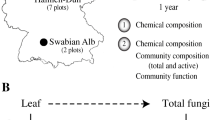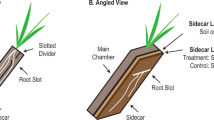Abstract
Stable isotope probing (SIP) provides the opportunity to label decomposer microorganisms that build their biomass on a specific substrate. In combination with high-throughput sequencing, SIP allows for the identification of microbial community members involved in a particular decomposition process. Further information can be gained (in SIP experiments) through gene-targeted metagenomics and metatranscriptomics, opening the possibility to describe the pool of genes catalyzing specific decomposition reactions in situ and to identify the diversity of genes that are expressed. When combined with gene descriptions of fungal and/or bacterial isolates from the same environment, specific biochemical reactions involved in decomposition can be linked to individual microbial taxa. Here, we describe the use of these methods to explore the decomposer community of fungi and bacteria in forest litter and soil.
Access this chapter
Tax calculation will be finalised at checkout
Purchases are for personal use only
Similar content being viewed by others
References
Berg B, Laskowski R (2006) Litter decomposition: a guide to carbon and nutrient turnover. Academic Press, Amsterdam
Clemmensen KE, Bahr A, Ovaskainen O, Dahlberg A, Ekblad A, Wallander H, Stenlid J, Finlay RD, Wardle DA, Lindahl BD (2013) Roots and associated fungi drive long-term carbon sequestration in boreal forest. Science 339:1615–1618
Baldrian P, Valášková V (2008) Degradation of cellulose by basidiomycetous fungi. FEMS Microbiol Rev 32:501–521
Berlemont R, Martiny AC (2013) Phylogenetic distribution of potential cellulases in bacteria. Appl Environ Microbiol 79:1545–1554
Koechli C, Campbell AN, Pepe-Ranney C, Buckley H, D.H. (2019) Assessing fungal contributions to cellulose degradation in soil by using high-throughput stable isotope probing. Soil Biol Biochem 130:150–1586
Wilhelm RC, Singh R, Eltis LD, Mohn WW (2019) Bacterial contributions to delignification and lignocellulose degradation in forest soils with metagenomic and quantitative stable isotope probing. ISME J 13:413–429
Lopez-Mondejar R, Tláskal V, Větrovský T, Štursová M, Toscan R, Nunes da Rocha U, Baldrian P (2020) Metagenomics and stable isotope probing reveal the complementary contribution of fungal and bacterial communities in the recycling of dead biomass in forest soil. Soil Biol Biochem 148:107875
Lopez-Mondejar R, Brabcová V, Štursová M, Davidová A, Jansa J, Cajthaml T, Baldrian P (2018) Decomposer food web in a deciduous forest shows high share of generalist microorganisms and importance of microbial biomass recycling. ISME J 12:1768–1778
Baldrian P, Kolařík M, Štursová M, Kopecký J, Valášková V, Větrovský T, Žifčáková L, Šnajdr J, Rídl J, Vlček Č, Voříšková J (2012) Active and total microbial communities in forest soil are largely different and highly stratified during decomposition. ISME J 6:248–258
Edwards IP, Upchurch RA, Zak DR (2008) Isolation of fungal Cellobiohydrolase I genes from Sporocarps and forest soils by PCR. Appl Environ Microbiol 74:3481–3489
Štursová M, Žifčáková L, Leigh MB, Burgess R, Baldrian P (2012) Cellulose utilization in forest litter and soil: identification of bacterial and fungal decomposers. FEMS Microbiol Ecol 80:735–746
Prévost-Bouré NC, Christen R, Dequiedt S, Mougel C, Lelièvre M, Jolivet C, Shahbazkia HR, Guillou L, Arrouays D, Ranjard L (2011) Validation and application of a PCR primer set to quantify fungal communities in the soil environment by real-time quantitative PCR. PLoS One 6:e24166
Amman RI, Ludwig W, Schleifer KH (1995) Phylogenetic identification and in situ detection of individual microbial cells without cultivation. Microbiol Rev 59:143–169
Wilmotte A, Van der Auwera F, de Wachter R (1993) Structure of the 16S ribosomal RNA of the thermophilic cyanobacterium Chlorogloeopsis HTF (Mastigocladus laminosus HTF) strain PCC7518, and phylogenetic analysis. FEBS Lett 317:96–100
Vetrovsky T, Baldrian P, Morais D (2018) SEED 2: a user-friendly platform for amplicon high-throughput sequencing data analyses. Bioinformatics 34:2292–2294
Nilsson RH, Anslan S, Bahram M, Wurzbacher C, Baldrian P, Tedersoo L (2019) Mycobiome diversity: high-throughput sequencing and identification of fungi. Nat Rev Microbiol 17:95–109
Acknowledgments
This work was supported by the Czech Science Foundation (20-14961S and 22-30769S).
Author information
Authors and Affiliations
Corresponding author
Editor information
Editors and Affiliations
Rights and permissions
Copyright information
© 2023 The Author(s), under exclusive license to Springer Science+Business Media, LLC, part of Springer Nature
About this protocol
Cite this protocol
Štursová, M., López-Mondéjar, R., Baldrian, P. (2023). Investigating the Bacterial and Fungal Communities Involved in Dead Biomass Degradation in Forest Soils. In: Martin, F., Uroz, S. (eds) Microbial Environmental Genomics (MEG). Methods in Molecular Biology, vol 2605. Humana, New York, NY. https://doi.org/10.1007/978-1-0716-2871-3_8
Download citation
DOI: https://doi.org/10.1007/978-1-0716-2871-3_8
Published:
Publisher Name: Humana, New York, NY
Print ISBN: 978-1-0716-2870-6
Online ISBN: 978-1-0716-2871-3
eBook Packages: Springer Protocols




